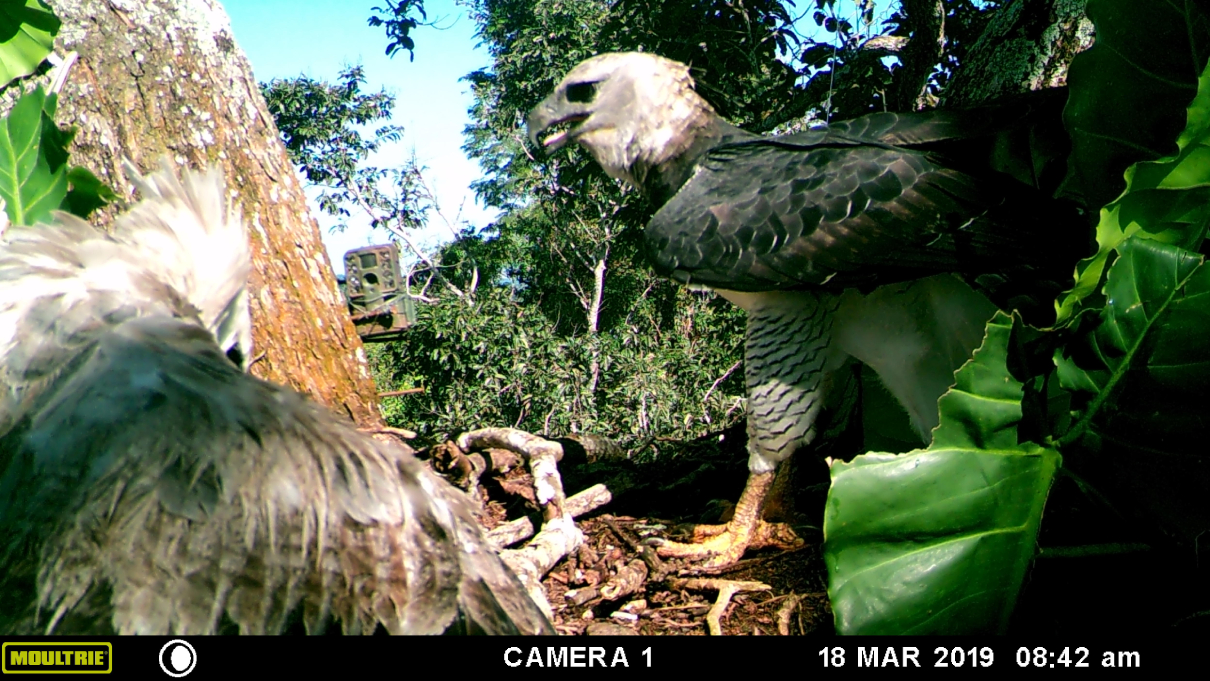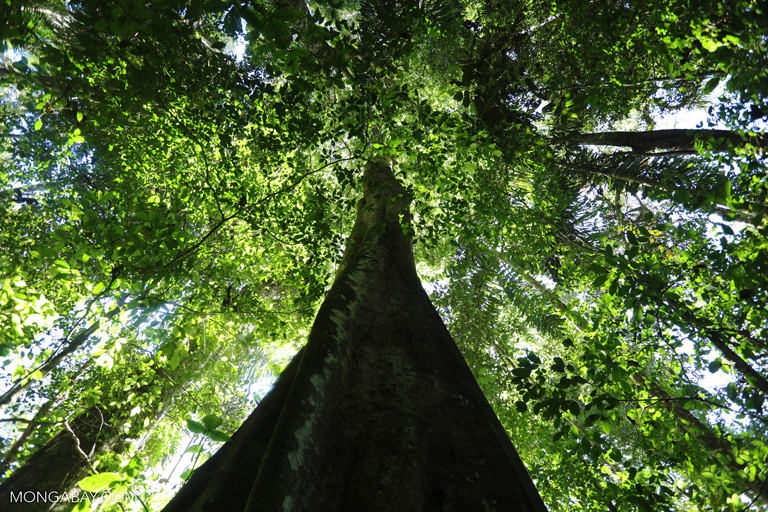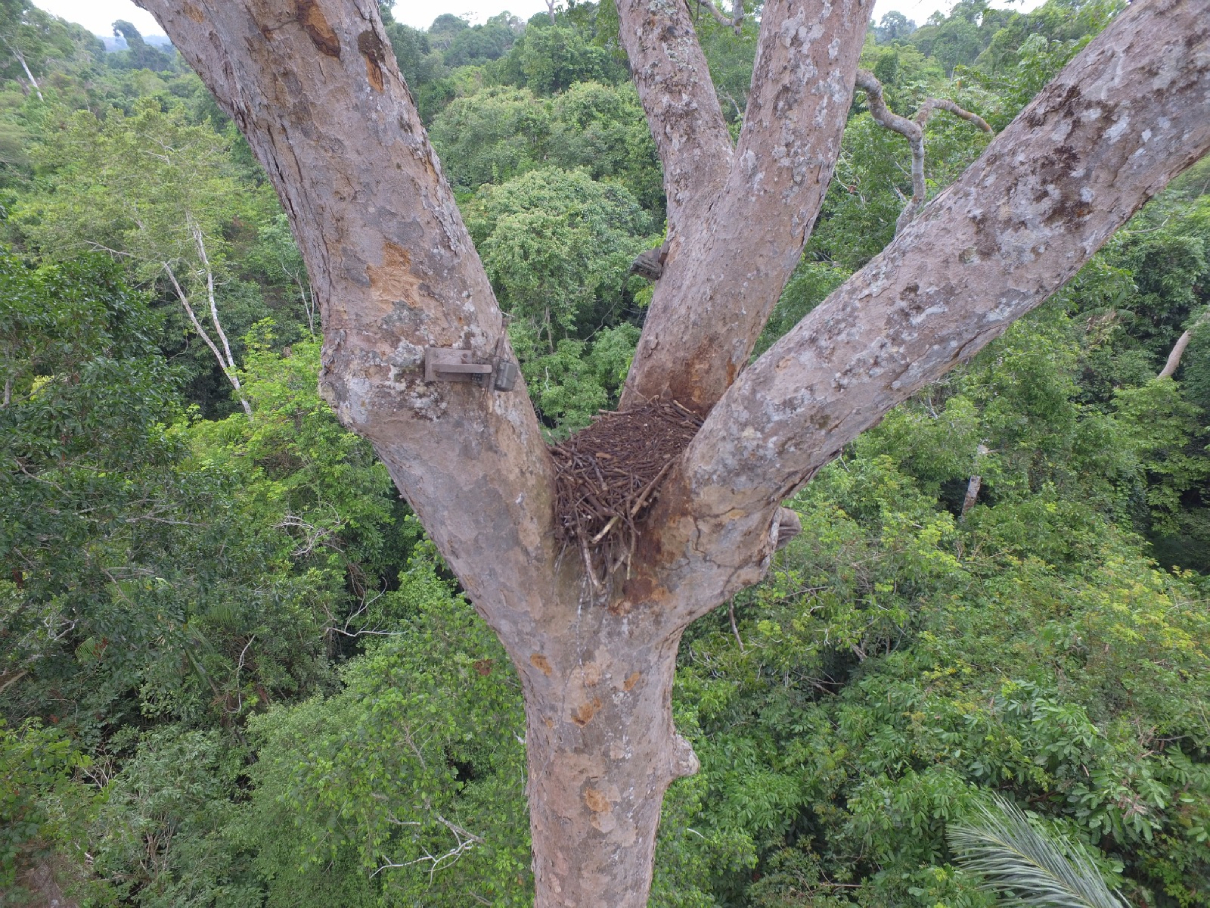- A new study finds that nesting trees for the harpy eagle in the Amazon are almost all targeted by the commercial timber industry.
- The eagles were found to select trees with specific architecture to support their nests and young.
- Tightening legal logging regulations and enforcement could help with the problem, but stamping out illegal logging is a more pressing challenge.
Selective logging has long been touted as an environmentally and ecologically favorable way to harvest timber, yet a new study adds to a growing body of evidence that suggests this isn’t entirely the case.
In the Amazon rainforest, the study shows, the same tree species used as nesting sites by the harpy eagle (Harpia harpyja) are almost all targeted by the commercial timber industry. The authors say that logging operations in the region could be causing wide-scale degradation to the habitat of one of the world’s largest eagles. The analysis was published in Biological Conservation.
“It’s absolutely a threat right now,” says lead author Everton Miranda, a Brazilian biologist at the University of KwaZulu-Natal in South Africa.
Harpy eagles once ranged from Mexico to northern Argentina, but their habitat and population have been pressured extensively by years of deforestation and hunting. The lowland Amazon now represents what the authors term the “last stronghold” for these birds, where 93% of the existing population are thought to live. Large eagles are known to build their nests on tall emergent trees that rise above the forest canopy, but which exact trees harpy eagles use wasn’t clear before.
Miranda and a team of researchers from the U.K. and Brazil pulled together all the information on known harpy nests and nesting trees in Latin America from the scientific literature, as well as unpublished studies and notes gathered from raptor biologists across the region. In total, they found information on 98 nests, the tree structures and surrounding vegetation.
They found harpy eagles to use just 28 tree species as nesting sites, out of an estimated 10,000 or so species across the Amazon Basin. Invariably, the eagles chose the tallest emergent trees in the vicinity, with specific structures able to support their nests.
The researchers had a hunch that these same trees would be sought after as timber by both legal and illegal loggers. So they checked the tree species against a pricing index for the commercial timber industry in the north Brazilian state of Pará, a logging hotspot that accounts for around half of all timber harvested in the Brazilian Amazon. Of the nesting trees, more than 92% were on the list, suggesting commercial interest both by legal timber concessions and illegal loggers.

Selective logging
The selective harvesting of timber is a widely used strategy in tropical forests. As opposed to clear-cutting a whole patch of forest, certain marketable tree species are cut down to produce timber and the rest are left standing. The forest is then allowed to recover, usually for two or three decades, before being harvested again.
Some studies suggest well-managed timber production forests can maintain levels of biodiversity comparable to protected or native forests. Many conservationists consider it to strike an adequate balance between commercial benefits and environmental protection.
In the Amazon, areas logged are currently higher than those deforested, though this is due to both legal and illegal logging across the region. “That’s the bad side, that there’s a massive area that’s been selectively logged,” says David Edwards, a professor of conservation science at the University of Sheffield, U.K., who was not involved in the study. “The good side is you’ve still got a forest at the end of it because it’s selective,” he says.
Other research has shown selective logging often leads to forest clearing anyway: one study found 16% of selectively logged forest areas in Brazil were subsequently deforested within a year. Opening up the canopy can also weaken surrounding trees and dry out the forest below, making it more susceptible to fire. It also disrupts dung beetle populations, key ecosystem engineers in the Amazon. And for species that depend on specific trees and tree architecture, like the harpy eagle, selective logging could present a more serious conservation problem.

Sought-after trees
The most popular nesting tree for the harpy in Amazonia was Ceiba pentandra, or kapok, which can tower up to 60 meters (200 feet) high. Its wood is used to create plywood and light construction, and its waxy seed fiber as insulation or mattress filler. In the Guiana Shield, harpy eagles mostly made their nests in the mighty Couratari guianensis, whose timber is used in carpentry and flooring, and which was classified as a vulnerable species in 1998.
The harpy eagles, formidable birds that grow up to 1 meter (3.5 feet) long, select these trees for their size, structure and strength. The height gives the apex predator the best panoramic view to scan for prey, and keeps its young away from any potential threats. The eagles prefer trees with broader crowns, and branches at shallower angles. These offer space for the young to learn how to fly and for adults to land on, as well as enough room and support to build what are among the largest nests of existing eagles, measuring up to 2.5 meters (8 feet) across.
“The structure they need is very specific,” Miranda says.
Aside from providing suitable homes for the harpy eagles, these mega-trees are essentially entire ecosystems unto themselves. “They not only present benefits in terms of harpy eagle nesting, but they are usually species that congregate a large amount of biodiversity,” Miranda says.
Harpy eagles play a critical role in these ecosystems. They control the population of capuchin monkeys, for example, which eat bird eggs and can even bring down palm trees by eating the palm hearts inside. Research suggests that prey carcasses dropped around trees by predatory birds may even work to disperse seeds.

Vanishing emergents?
It’s difficult to know exactly how many of these trees have been felled in the region, as illegal logging is rife and monitoring is difficult. Peru, Ecuador and Colombia all suffer from high levels of illegal timber harvesting and exportation. Federal police in Brazil’s Amazonas state recently said upwards of 90% of timber leaving the Amazon is of criminal origin.
“We don’t have good estimates for how much of the Amazon has been logged. You have illegal wood extraction essentially everywhere,” Miranda says.
Edwards says the findings highlight a potential conservation problem. Yet he cautions it’s difficult to extrapolate the results to the effects on harpy eagle populations.
“Short of going around and actually finding nest-trees, it will be difficult to know the overall impact,” he says. Their population density in a given area is very low, he adds, and they can probably relocate to another emergent.
Yet in the context of intensive illegal logging, Edwards says, the findings are particularly worrying. “Making sure we get a grip on that is important,” he says.
“Sustainable forest management guidelines do not allow the removal of all mother trees of a certain species in a production area,” says Saulo Souza, a postdoctoral research associate at the University of Exeter, U.K., who was also not involved in the study. “The retention of seed trees can reach up to 15%.”
Souza notes the success of a law prohibiting loggers from felling Brazil nut trees (Bertholletia excelsa), which he says are frequently used by harpy eagles. (These were excluded from Miranda’s study).
“The best practice is to carefully select trees to harvest, and exclude trees with nests, especially of animals considered officially under threat of extinction,” Souza says. The harpy eagle is not considered a threatened species on the IUCN Red List, though the study authors say the “extensive habitat degradation” should be considered in the next assessment.
Yet regulatory loopholes are allowing more intensive harvests to happen, research shows, and illegal loggers are finding ways to get round legal safeguards. Volumes for commercially valuable trees are being artificially inflated in timber licenses, for example, allowing criminals to launder the wood. Meanwhile, enforcement has been reduced in Brazil, where funding for IBAMA, the federal environment agency, has been cut under the administration of President Jair Bolsonaro.
“The impetus from this study for me is just really underscoring how [conservationists] want to work with governments, regional governments, with logging companies, to be following best practice and equally to be stamping down hard on illegal logging,” Edwards says.
“The problem brought by the paper is certainly minimised if proper forest management is applied,” Souza adds. “And of course, if illegal harvesting is banned.”
Citations:
Miranda, E. B., Peres, C. A., Marini, M. Â., & Downs, C. T. (2020). Harpy eagle (Harpia harpyja) nest tree selection: Selective logging in Amazon forest threatens Earth’s largest eagle. Biological Conservation, 250, 108754. doi:10.1016/j.biocon.2020.108754
Miranda, E. B., Menezes, J. F., Farias, C. C., Munn, C., & Peres, C. A. (2019). Species distribution modeling reveals strongholds and potential reintroduction areas for the world’s largest eagle. PLOS ONE, 14(5), e0216323. doi:10.1371/journal.pone.0216323
Ter Steege, H., Mota de Oliveira, S., Pitman, N. C., Sabatier, D., Antonelli, A., Guevara Andino, J. E., … Salomão, R. P. (2019). Towards a dynamic list of Amazonian tree species. Scientific Reports, 9(1). doi:10.1038/s41598-019-40101-y
Richardson, V. A., & Peres, C. A. (2016). Temporal decay in timber species composition and value in Amazonian logging concessions. PLOS ONE, 11(7), e0159035. doi:10.1371/journal.pone.0159035
Wilcove, D. S., Giam, X., Edwards, D. P., Fisher, B., & Koh, L. P. (2013). Navjot’s nightmare revisited: Logging, agriculture, and biodiversity in Southeast Asia. Trends in Ecology & Evolution, 28(9), 531-540. doi:10.1016/j.tree.2013.04.005
Tobler, M. W., Garcia Anleu, R., Carrillo-Percastegui, S. E., Ponce Santizo, G., Polisar, J., Zuñiga Hartley, A., & Goldstein, I. (2018). Do responsibly managed logging concessions adequately protect jaguars and other large and medium-sized mammals? Two case studies from Guatemala and Peru. Biological Conservation, 220, 245-253. doi:10.1016/j.biocon.2018.02.015
Asner, G. P., Broadbent, E. N., Oliveira, P. J., Keller, M., Knapp, D. E., & Silva, J. N. (2006). Condition and fate of logged forests in the Brazilian Amazon. Proceedings of the National Academy of Sciences, 103(34), 12947-12950. doi:10.1073/pnas.0604093103
Brocardo, C. R., Gonçalves, H. S., Zipparro, V. B., & Galetti, M. (2010). Predation of adult palms by Blackcapuchin monkeys (Cebus nigritus) in the Brazilian Atlantic Forest. Neotropical Primates, 17(2), 70-74. doi:10.1896/044.017.0205
Nogales, M., Quilis, V., Médina, F. M., Mora, J. L., & Trigo, L. S. (2002). Are predatory birds effective secondary seed dispersers? Biological Journal of the Linnean Society, 75(3), 345-352. doi:10.1046/j.1095-8312.2002.00024.x
Carvalho, W. D., Mustin, K., Hilário, R. R., Vasconcelos, I. M., Eilers, V., & Fearnside, P. M. (2019). Deforestation control in the Brazilian Amazon: A conservation struggle being lost as agreements and regulations are subverted and bypassed. Perspectives in Ecology and Conservation, 17(3), 122-130. doi:10.1016/j.pecon.2019.06.002
